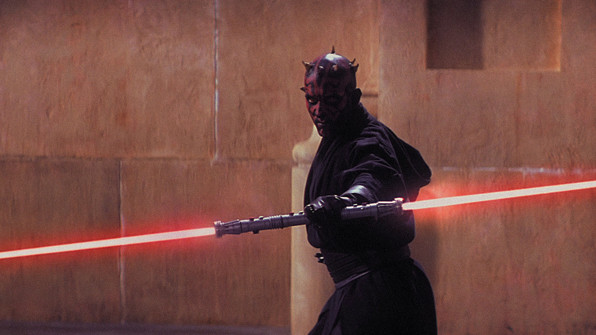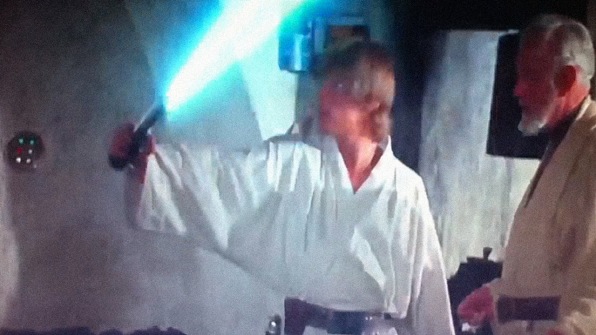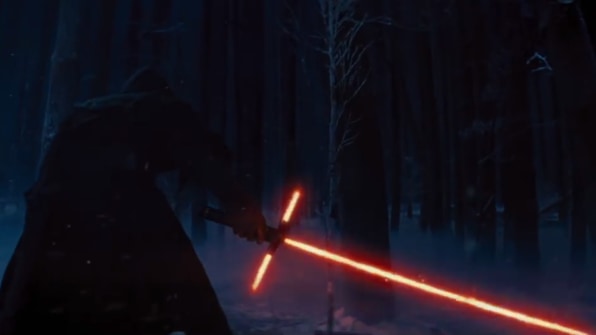Star Wars Battle Command How to Build a Good Defense
I think we can all agree that there's definitely a need for some kind of wrist protection for lightsabers. Hands get chopped off in the Star Wars universe so often, uber-fans have made up a whole imaginary school of lightsaber combat to try to make sense of it. Not only did Luke Skywalker get his hand cut off by a lightsaber, his dad's hand was lopped off by a laser blade twice. And heck, check out this clip:
Look at how easily Anakin Skywalker severed both of Count Dooku's hands in Revenge of the Sith just by running his blade up the shaft. If Dooku had a crossguard on his lightsaber, this never would've happened!
So yes, the Star Wars universe needs crossguards. But J.J. Abrams's particular solution to the problem is making the Internet laugh. Critics say the lightsaber crossguard is more likely to make Driver (or whoever that is) sever his own hand than actually protect him from someone else's blade. Even if the crossguard did work as intended, it looks silly, these critics argue.
I couldn't disagree more. I'm excited by what this new lightsaber says about J.J. Abrams's story-driven approach to the Star Wars universe. In fact, if you think it looks silly, I'd argue you're not looking at it in the right way. This is great design, through and through. Here's why.
Every lightsaber tells a story
Let me start by making a simple observation: like the design of any similarly iconic weapon from cinema, the most important thing about a lightsaber's design isn't whether or not it's practical to fight with in the real world. It's what it tells us about the person holding it.

Consider, for example, the difference between Obi-Wan Kenobi's blue, single-bladed lightsaber as seen in A New Hope (which conveys that he is a gentleman knight from a more elegant time) and Darth Maul's red double-bladed lightsaber from The Phantom Menace (which is the weapon of a ferocious and incredibly agile animal who will stop at nothing to draw blood). Neither of these weapons is practical in any real sense of the word, because a laser sword that can effortlessly cut through anything can never be practical: you'd dismember yourself the first time you accidentally tapped yourself with it. But when Obi-Wan Kenobi and Darth Maul fight at the end of The Phantom Menace, it is the fact that they are fighting with these swords in particular that tells us everything we need to know about what is actually at stake: the end of a more civilized and enlightened time, and the beginning of an age of bloodshed, cruelty, and strife.
So when judging the new lightsaber in The Force Awakens trailer, the first thing we should be judging it by is what it tells us about its owner. Which is a lot.
Defining a new Darth Vader
In the Star Wars movies there are only ever two Sith Lords: a master and an apprentice. So when Emperor Palpatine and Darth Vader die at the end of Return of the Jedi, that's it. The Sith are extinct. Yet here's maybe Adam Driver, wielding a Sith lightsaber, around 30 years after the end of the Sith Order. Where did he get it?

Did he find it? It's possible, but every clue in the trailer suggests that he made it. Notice how the lightsaber sputters, crackles, and flickers as the character turns it on. As io9 notes, that's a sign of shoddy workmanship. But don't just look at it, listen to it. The sound of a lightsaber turning on is always smooth around the edges, but this lightsaber sounds dirty, and full of static. These are all design choices, consciously made to tell us, the viewers, something about what we're seeing.
Listen to the trailer's narration. "There has been an awakening. Have you felt it? The dark side." Combined with everything else, that says everything you need to know: The Force Awakens is about the rebirth of the Sith after their destruction. The character in the trailer is formative to that. And without a master to guide him, he's rebuilding the Sith order from scratch, which includes figuring out how to create a lightsaber for himself, warts and all.
So if the anonymous villain created this lightsaber himself, why did he design it with a crossguard at all? Simple: he knows he's vulnerable to getting his hands cut off, because he's not skilled. He has no training. If a regular lightsaber is a katana, this is a claymore: a brutal and unsophisticated weapon favored by a vicious, untrained fighter who is relying upon brute strength to chop his opponents to pieces.
Conclusion
The crossguard says so much about the character wielding it. After all of the silly lightsaber ballet of the prequels, it opens up a whole new dynamic, and immediately differentiates the character in the trailer from every Star Wars baddie who has come before him. This isn't the lightsaber of a trained warrior in his prime, like in the prequels, or a retired Jedi who hasn't fought in 30 years, like in Episodes IV through VI. This is the lightsaber of a bloodthirsty young berserker.

Granted, there might have been other ways for J.J. Abrams to convey, through lightsaber design, the idea of the brutal, untrained warrior. In novels, games, and comics, the Star Wars universe has established a number of materials that can't be harmed by lightsabers. From a practical perspective, surely these would be better for protecting someone's hands and wrists than a crossguard made out of lasers that will cut right through your wrist if you swing it wrong. But they wouldn't look as distinctive on film, and they would require explanation in the script about the metallurgy of the Star Wars universe. If you thought hearing about midichlorians in The Phantom Menace was bad, imagine sitting through a jaunt through the Star Wars periodic table.
Which is why, from a cinematic perspective, the lightsaber crossguard we're seeing in The Force Awakens trailer is such incredible design. It's not just visually arresting. It's efficient. We know what we're seeing immediately, no explanation needed. And not only that, it illuminates a character's personality, and fighting style with just the flip of a switch. It helps tell a story. And when it comes to the language of cinema, that's the only design problem worth solving.
Star Wars Battle Command How to Build a Good Defense
Source: https://www.fastcompany.com/3039210/in-defense-of-the-new-star-wars-lightsaber
0 Response to "Star Wars Battle Command How to Build a Good Defense"
Post a Comment